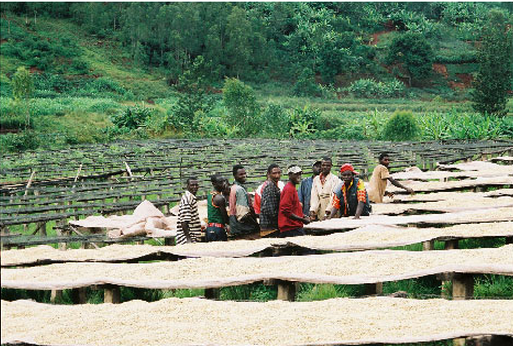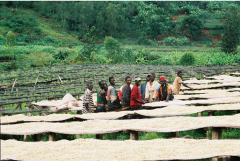Raw beans wholesale Burundi Heart of Africa AA freshly roasted boutique coffee beans
For professional baristas, please follow the coffee workshop (Wechat official account cafe_style)
Burundi is located south of the equator in east-central Africa. It is bordered by Rwanda to the north, Tanzania to the east and south, Congo (Kinshasa) to the west, and Lake Tanganyika to the southwest. There are many plateaus and mountains in the territory, most of which are composed of the plateau on the east side of the East African Rift Valley, with an average elevation of 1600 meters above sea level, which is known as the "mountain country". More than half of them are located on the famous lake Lake Tanganyika. The capital is Bujumbura. The lakeside and river valleys in the west and the savanna climate in the east; the tropical mountain climate in the central and western regions. The annual average temperature is 20-24 ℃, with a maximum of 33 ℃. The heavy rainy season is from March to May, the light rainy season is from October to December, and the other months are dry season.
Burundi has the most diverse and successful coffee industry in the world, and has its own characteristics. Coffee in this country was introduced by Belgian colonists in 1930 and is now grown only on small farms. Unfortunately, many of these farms are on the border with war-torn Rwanda, putting pressure on coffee production. Almost all coffee produced in Burundi is Arabian coffee beans, while coffee trees in Ngozi are planted at an altitude of more than 1200 meters. Burundian coffee has a rich aroma and excellent acidity, and most of its products are exported to the United States, Germany, Finland and Japan.
The origin of the town of Reuters, which is a cooperative organized by small family coffee farmers, has a total of 539 small coffee farmers, of whom 148 are women. on average, each family grows 10,200 coffee trees (at least 1000 coffee trees per hectare), which shows its weak annual income and is a typical poor small coffee farmer family.

Burundian coffee bears a striking resemblance to neighboring Rwanda, where coffee from the two countries is often confused. Burundian coffee is mainly grown in bourbon, with traditional wet processing of coffee cherries. Its boutique coffee is characterized by elegant sweetness and bright citrus aromas. This batch belongs to bourbon species micro batch.
[Bulongdi Champion processing Plant] is located in the Maerdadi Peak of the Panjia processing Plant in Cabuye District, Cajun Province, with a very high altitude, even more than 2000 meters in the mountainous area. the soil is fertile and gravelly, which is very suitable for coffee growth. it is recognized as the best coffee processing plant in Bulongdi.
Bean parameters:
Country: Burundi
Growth: 1750 m
Production area: Kayanza Kabuye
Baking degree: medium baking
Treatment method: traditional wet treatment
Variety: bourbon species
Processing plant: Parnjia processing plant
Flavor: sour citrus, lemon, orange, almond aromas
Taste: citrus acidity, lemon, orange, almond aromas, tangerine peel aromas, clean, round and balanced with a long finish.
Taobao link: https://item.taobao.com/item.htm?spm=a1z10.5-c.w4002-15673140460.41.22f7333b1ud5mF&id=532974896074
Important Notice :
前街咖啡 FrontStreet Coffee has moved to new addredd:
FrontStreet Coffee Address: 315,Donghua East Road,GuangZhou
Tel:020 38364473
- Prev

The origin of Yunnan small-grain coffee, the oldest native variety in Ethiopia.
Professional barista communication Please follow the coffee workshop (Wechat official account cafe_style). I am a coffee lover. I always say that beans in Yunnan are very ordinary, but today I was surprised that the boss's wife is also a coffee lover. In order to pass the time, she opened her own coffee shop. Today, I went out of my way to gather popularity. The landlady took out half a pound and claimed to be from Yunnan Dehong.
- Next

2017 New Season Burundi Heart of Africa Washed Bourbon Boutique Coffee
Professional barista exchanges, please pay attention to coffee workshop (Weixin Official Accounts cafe_style) Burundi is located in the south of the equator in central and eastern Africa. It borders Rwanda to the north, Tanzania to the east and south, Congo to the west and Lake Tanganyika to the southwest. There are many plateaus and mountains in the territory, most of which are composed of plateaus on the east side of the Great Rift Valley in East Africa. The average altitude of the whole country is 1600 meters, so it is called Mountain Country.
Related
- Detailed explanation of Jadeite planting Land in Panamanian Jadeite Manor introduction to the grading system of Jadeite competitive bidding, Red bid, Green bid and Rose Summer
- Story of Coffee planting in Brenka region of Costa Rica Stonehenge Manor anaerobic heavy honey treatment of flavor mouth
- What's on the barrel of Blue Mountain Coffee beans?
- Can American coffee also pull flowers? How to use hot American style to pull out a good-looking pattern?
- Can you make a cold extract with coffee beans? What is the right proportion for cold-extracted coffee formula?
- Indonesian PWN Gold Mandrine Coffee Origin Features Flavor How to Chong? Mandolin coffee is American.
- A brief introduction to the flavor characteristics of Brazilian yellow bourbon coffee beans
- What is the effect of different water quality on the flavor of cold-extracted coffee? What kind of water is best for brewing coffee?
- Why do you think of Rose Summer whenever you mention Panamanian coffee?
- Introduction to the characteristics of authentic blue mountain coffee bean producing areas? What is the CIB Coffee Authority in Jamaica?

